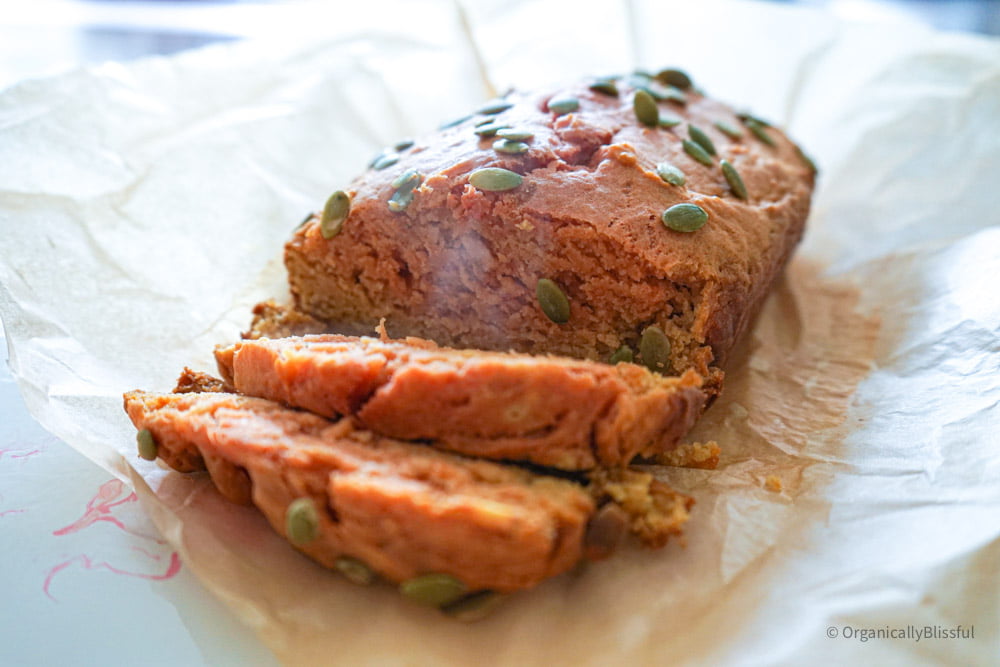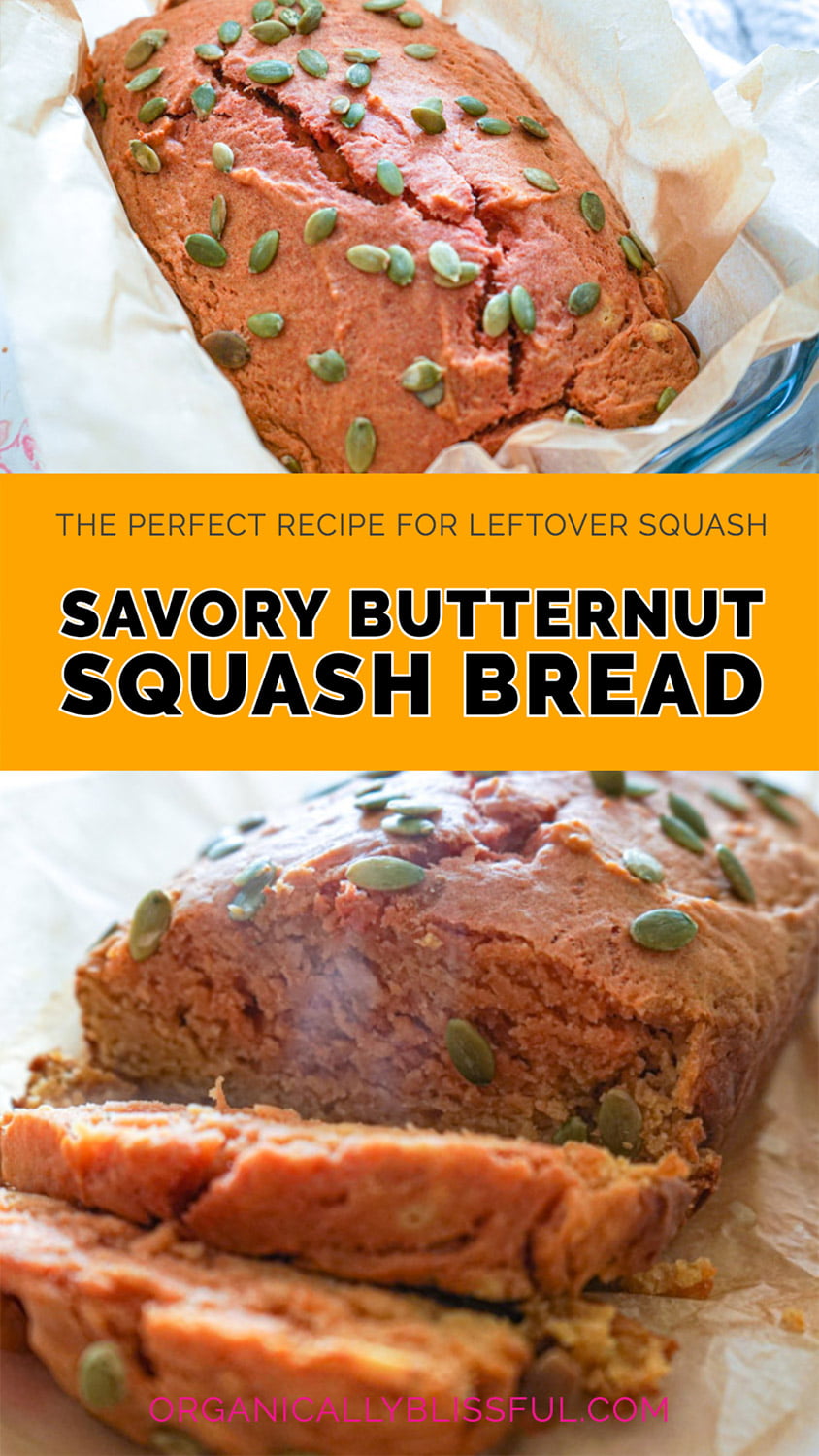As the leaves turn and the air grows crisp, there's nothing quite like the warm, inviting aroma of freshly baked bread wafting through the kitchen. But this isn't just any bread; Savory butternut squash bread is a delightful twist on the traditional, incorporating the rich, sweet notes of butternut squash to create a savory loaf that's irresistibly moist and tender. Perfect for those who love a hint of sweetness in their savory dishes, this butternut squash bread is a fantastic addition to any meal, be it a hearty stew or a simple spread of cheese and wine.
In this post, I will show you how to make butternut squash bread with only a handful of ingredients along with some tricks and tips to make the perfect loaf of butternut squash bread.
Homemade Butternut Squash Bread Recipe
Prep Time
10 minutes
Cook Time
60 minutes
Rest Time
0 minutes
Total Time
70 minutes
Ingredients
Dry Ingredients
Wet Ingredients
Toppings
Directions
1. Cook the butternut squash until it is fully cooked and then mash it.
2. To prepare, preheat the oven to 350°F (175°C) and either grease a loaf pan with coconut oil or line it with parchment paper.
3. In a large mixing bowl, combine the whole wheat flour, baking powder, baking soda, salt, cinnamon, nutmeg, and cloves. Whisk the ingredients together thoroughly and set the mixture aside.
4. In a separate bowl, vigorously whisk the eggs until they are thoroughly beaten. Add the maple syrup or honey, melted coconut oil, butternut squash puree, applesauce, and vanilla extract. Continuously stir until the ingredients are thoroughly blended together.
5. Gently pour the wet ingredients into the bowl containing the dry ingredients. Utilize a spatula or wooden spoon to combine everything until it is mixed delicately. Exercise caution not to overmix, as it may result in denser bread.
6. Transfer the batter to the loaf pan that has been prepared, ensuring an even distribution. Sprinkle the pumpkin seeds on top of the batter, evenly scattering them.
7. Put the pan in the preheated oven and bake for around 50-60 minutes, or insert a toothpick into the center comes out clean
8. After fully cooked bread, take it out of the oven and allow it to cool in the pan for approximately 10 minutes. Then, transfer it to a wire rack to cool completely before slicing.
9. Slice and serve the healthy butternut squash bread as desired. It can be enjoyed plain, with a spread of nut butter, or even with a dollop of Greek yogurt and a drizzle of honey.

Tips & Notes
Choose a ripe butternut squash: Look for a firm squash with a dull skin color and no soft spots. Ripe squash will yield a sweeter and more flavorful puree.
Don't overmix the batter: Excessive mixing can produce a dense and tough texture. Stir the wet and dry ingredients together only until they are combined. Don't worry if there are a few lumps in the batter.
Allow the bread to cool completely: While it may be tempting to slice it while it's still warm, it is recommended to let it cool completely on a wire rack. This allows the bread to set and enhances its texture.
Nutritional Facts
Nutrition Facts
Servings: 12
Calories
165
% Daily Value*
Total Fat 5.7g
7%
Saturated Fat 4.8g
24%
Cholesterol 27mg
9%
Sodium 162mg
7%
Total Carbohydrate 25.7g
9%
Dietary Fiber 0.9g
3%
Total Sugars 9g
Protein 2.9g
Vitamin D 3mcg
13%
Calcium 41mg
3%
Iron 1mg
7%
Potassium 108mg
2%
*The % Daily Value (DV) tells you how much a nutrient in a food serving contributes to a daily diet. 2,000 calorie a day is used for general nutrition advice.
Spice substitute: If you have no spice for this recipe, don't panic. You can use pumpkin spice instead.
What Ingredients You Will Need To Make Butternut Squash Bread
Whole Wheat Flour
Whole wheat flour is created by grinding the complete wheat kernel, including the bran, germ, and endosperm. Compared to refined flour, it retains more nutrients and dietary fiber. Whole wheat flour adds a nutty flavor and a hearty texture, boosting the butternut squash bread's nutritional value.
Baking Powder
Baking powder, an essential leavening agent, aids in the rising of the bread. It is composed of a mixture of baking soda, cream of tartar, and occasionally cornstarch. When mixed with moisture and heat, baking powder releases carbon dioxide gas, causing the bread to expand and become light and fluffy.
Baking soda, or sodium bicarbonate, serves as an additional leavening agent. When combined with acidic ingredients like buttermilk or vinegar in the batter, it reacts to generate carbon dioxide gas bubbles. This process helps the bread rise and creates a tender texture.
Salt is a flavor enhancer that balances the sweetness and brings out the other flavors in the bread. It also regulates yeast activity and strengthens the gluten structure, resulting in a better texture.
Ground Cinnamon
Ground cinnamon is a warm, aromatic spice that adds a cozy and comforting flavor to the bread. It pairs perfectly with the butternut squash and other spices, creating a delightful blend of flavors.
Ground Nutmeg
Ground nutmeg has a slightly sweet and nutty flavor, adding depth and complexity to the bread. It works harmoniously with the other spices, enhancing the overall taste experience.
Ground Cloves
Ground cloves offer a robust and unmistakable flavor profile characterized by subtle sweetness and spiciness. They contribute warmth and depth to the bread, enhancing its overall complexity and aroma.
Eggs
Eggs fulfill various roles in baking. They serve as a binding agent that aids in the cohesion of the ingredients. They also provide moisture, richness, and structure to the bread. Additionally, they aid in leavening and contribute to a light and fluffy texture.
Pure Maple Syrup
These natural sweeteners add sweetness and flavor to the bread while providing some additional nutrients. In addition to maple syrup, you can use brown sugar, honey, coconut sugar, or dates syrup.
Coconut Oil
Coconut oil, derived from plants, imparts moisture and richness to the bread while infusing a subtle coconut flavor. Due to its unique composition of medium-chain fatty acids, coconut oil is considered a healthier option compared to some other oils. If you don't like the taste of coconut oil, try avocado oil or melted butter instead. Avoid using olive oil, as it has a low smoking point.
Butternut Squash Puree
To create butternut squash puree, cook the squash flesh and then mash it into a smooth consistency. It adds natural sweetness, moisture, and a vibrant golden color to the bread. Butternut squash is a nutrient-dense vegetable, rich in vitamins A and C and dietary fiber.
Unsweetened Applesauce
Unsweetened applesauce is a natural sweetener that can be used as a partial substitute for oil in bread. It contributes moisture and tenderness and imparts a delicate apple flavor. Applesauce also helps reduce the overall fat content of the bread while maintaining its deliciousness.
Vanilla Extract
Vanilla extract elevates the bread's overall flavor profile, adding a delightful enhancement. It adds a sweet and aromatic note that complements the other ingredients, providing depth and balance.
Pumpkin Seed
Adding pumpkin seeds to your bread can be a wonderful way to introduce additional texture, flavor, and nutritional value. Pumpkin seeds, commonly referred to as pepitas, are the edible seeds found within pumpkins. They possess a mildly sweet and nutty taste that can beautifully complement the flavor of the bread.

Frequently Asked Questions (FAQ)
How To Store Leftovers
To maintain the bread's freshness, preserve it in an airtight container or tightly wrap it in plastic wrap. The bread can be stored at room temperature for approximately 3-4 days. Store it in a cool and dry area, away from direct sunlight or heat sources.
For extended storage, refrigerate the bread. It will remain fresh for up to a week when kept refrigerated. Please be aware that refrigeration may cause a slight alteration in the bread's texture, resulting in a denser consistency.
For long-term storage, freezing is the ideal choice. Wrap the bread tightly in plastic wrap and then place it in a freezer bag or airtight container. This will help maintain its quality and freshness. Frozen bread can last for up to 2-3 months.
Can I Use Canned Butternut Squash Puree Instead Of Fresh?
Yes, canned butternut squash puree can conveniently substitute fresh puree. Just make sure to use pure butternut squash puree without any additional ingredients or seasonings. If butternut squash puree is unavailable, you can use pumpkin puree, sweet potato puree, or another type of canned squash.
Can I Use Other Winter Squash Varieties Instead Of Butternut Squash?
Yes, feel free to explore and experiment with other winter squash varieties, such as acorn squash, kabocha squash, or even pumpkin, and make pumpkin bread. They will impart slightly different flavors but should work well in the recipe.
